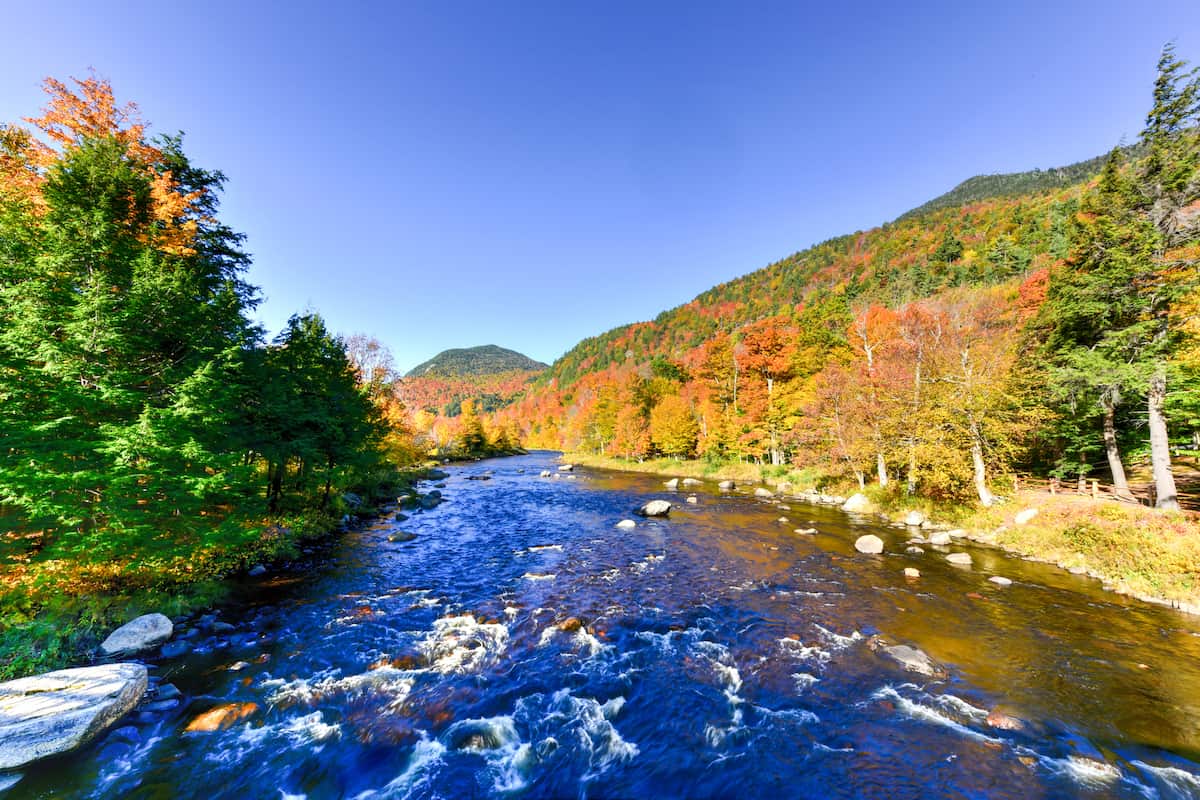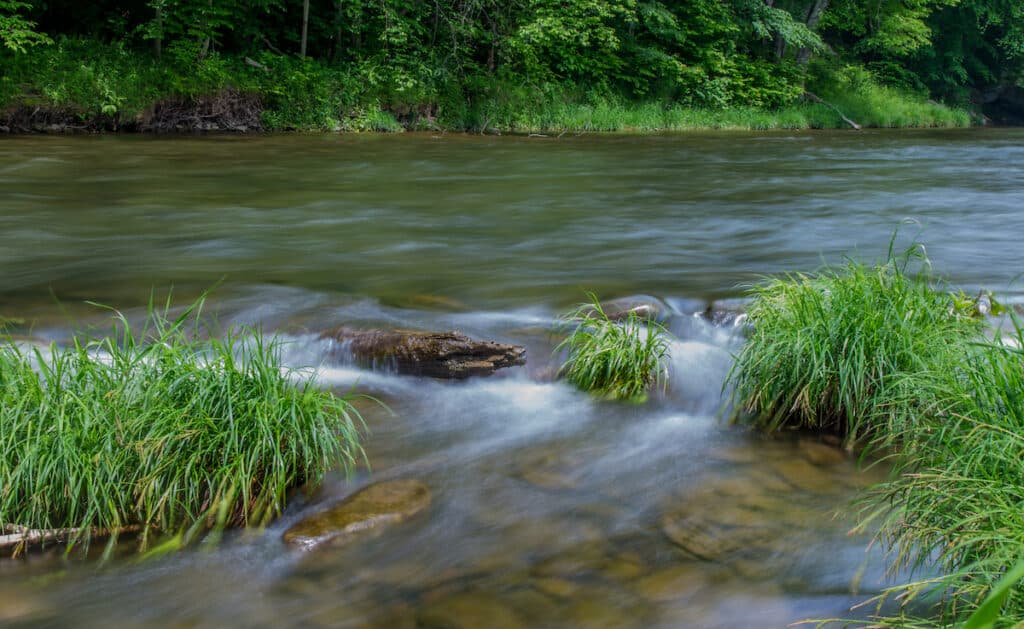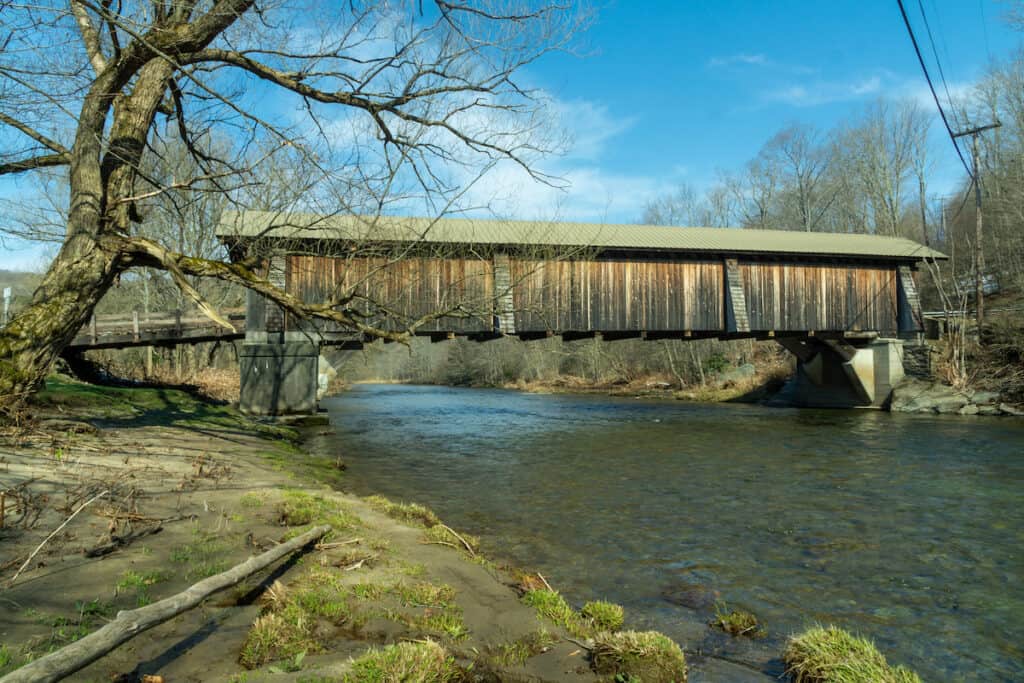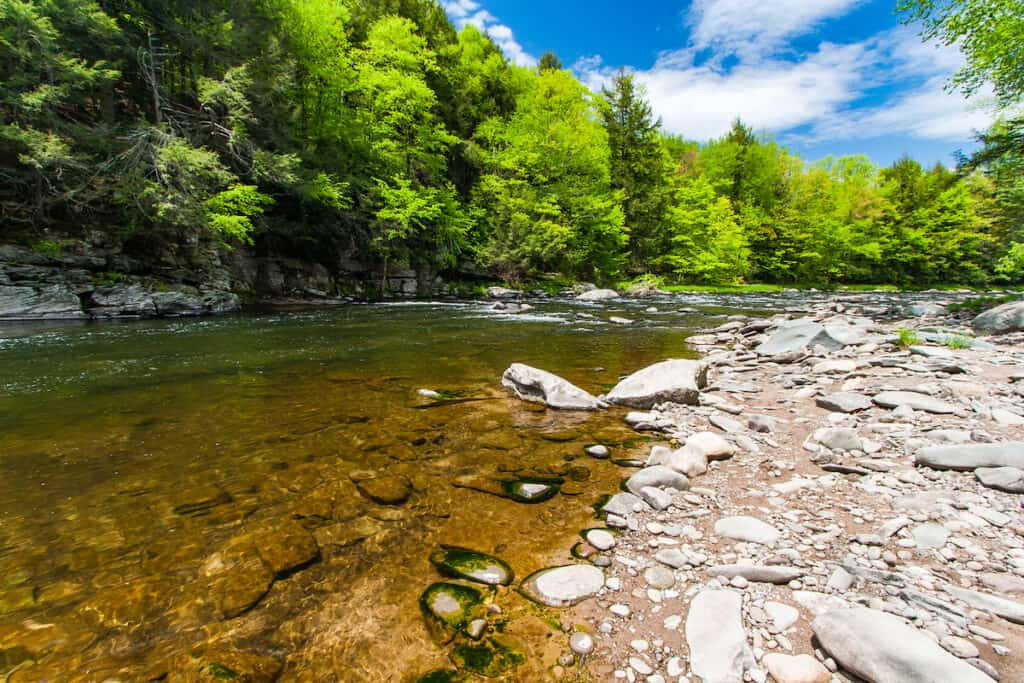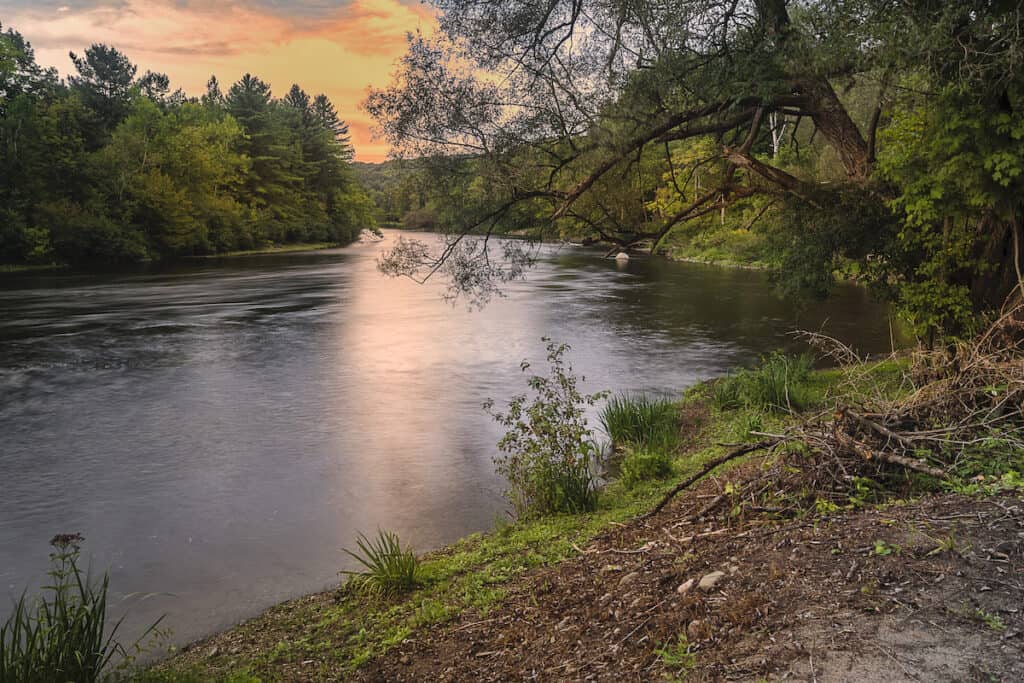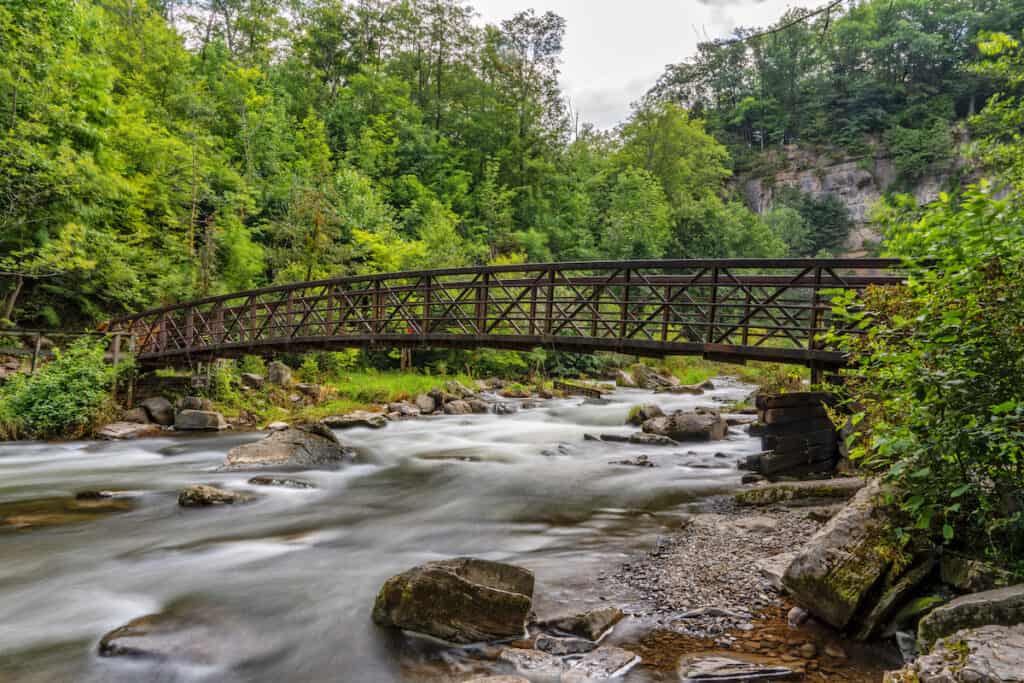If your vision of New York involves skyscrapers and traffic jams, think again. Fly fishers and conventional trout anglers in the Empire State have a very different vision.
Thousands of miles of prime trout streams meander through the state of New York, many of them fed by clean, cold snowmelt from the state’s rugged Catskill and Adirondack Mountains.
Trout Fishing in New York State
Brook trout, brown trout and rainbow trout are all abundant in New York’s waters, and especially in the top rivers and creeks we reveal in this article.
These streams’ fish include some very healthy populations of wild trout in addition to hatchery-raised trout that are stocked every year by the New York Department of Environmental Conservation (DEC).
New York’s main trout season runs from April 1 to October 15 every year. Even so, catch-and-release trout fishing is permitted on most waters year-round.
Whether your idea of a successful day on the water involves fly fishing for scrappy wild brook trout in a mountain stream or casting spoons for monstrous brown trout on a broad river, you’ll find plenty of opportunities for both in New York.
Whatever your tactic of choice, there’s no doubt that some of the best trout streams in the Eastern U.S. flow through the state of New York. The DEC maintains public access to nearly all these rivers and streams.
These access areas, referred to as Public Fishing Rights (PFR), are usually clearly marked with yellow signage that reads “Public Fishing Stream.” Maps showing these areas are also available on the DEC website.
With so many potential rivers and creeks to choose from, the easiest way to approach trout fishing in New York is to break it down by region.
Trout Streams in the Catskills
Most New York trout anglers would agree that the Catskill Mountains are home to the state’s finest fly water.
The Catskills have been called “the birthplace of American fly fishing,” and it’s no exaggeration to say that several of the best trout streams in the East flow through these mountains.
Delaware River
Arguably New York’s finest trout stream, the Delaware River system really consists of three rivers.
The East Branch and West Branch Delaware River are each outstanding trout rivers in their own rights, and they merge to form the main stem of the Delaware in the town of Hancock.
From there, the Delaware River follows the New York/Pennsylvania state line, eventually traversing 300 miles and becoming a broad, powerful river by the time it empties into the Atlantic between New Jersey and Delaware.
Within New York alone, this river system offers enough water to keep any angler busy for a lifetime.
Some of the best trout fishing is in the West Branch Delaware River, specifically in the 12-mile stretch from Cannonsville Reservoir down to its confluence with the East Branch.
Trout are not stocked in this stretch, which means that anything you catch is wild.
Brown trout measuring 14 to 16 inches are common, and there are decent numbers of rainbows as well, many of which migrate upstream from the Delaware’s main stem in spring.
The DEC provides over a mile of Public Fishing Rights and five angler parking areas in and around the village of Deposit, which is immediately downstream from the Cannonsville Dam.
This is a great tailwater fishery in any season because releases from the dam help regulate the water temperature. Hardy locals catch trout here in the dead of winter. Even so, the best time to take advantage of the river’s abundant insect hatches is the month of May.
March Brown Mayfly, Hendrickson, Sulphur, Blue Winged Olive and Green Drake are all on the menu for trout at various times throughout late spring and early summer. Come armed with a variety of dry flies if you intend to match the hatch.
If you’re looking for more secluded water, the DEC provides many miles of Public Fishing Rights on the portion of the West Fork above Cannonsville Reservoir.
There are some beautiful pools up here, and 12,000 hatchery brown trout are stocked above the reservoir every year.
The East Fork of the Delaware is almost as good as its western counterpart. The 30-mile stretch below Pepacton Reservoir is an incredible tailwater fishery, where stocked and wild brown trout coexist, and fish measuring 20 inches are possible.
Both branches of the Delaware River also support wild brook trout, which are more common in their upper reaches and in smaller tributaries.
More: Complete Guide to Delaware River Fishing
Beaverkill River
The Beaverkill River—often written as Beaver Kill—is a major tributary of the East Branch Delaware River, and perhaps the most iconic trout stream in the Catskills.
The Beaverkill has historically been known as a retreat for artists, writers, and the earliest pioneers of fly fishing.
Wild brown trout inhabit all areas of the river, and wild brook trout are common in the upper Beaverkill (above the hamlet of Roscoe), increasing in abundance as you move upstream.
The DEC stocks an additional 18,000 brown trout annually, and rainbow trout have also been “unofficially” stocked in various sections by private landowners.
The upper portion of the river is characterized by boulder-strewn pools and pocket water, while the lower Beaverkill features faster riffles and deeper pools.
Fly anglers can count on major hatches of at least a dozen different species. Quill Gordon Mayflies are usually the first to emerge in April, and there are major Hendrickson and Green Drake hatches from May into June.
Blue Winged Olives are the big one though. They hatch at various times from late April through October, often rising from the water in thick clouds during late morning and early afternoon.
The river offers a lot of classic dry fly water, and is best fished in mid- to late spring. During summer, the Beaverkill warms to a point where all but the deepest pools become unproductive.
The DEC maintains many miles of Public Fishing Rights, mostly on the lower Beaverkill.
Roscoe, NY (dubbed “Trout Town USA”) is located at the spot where Willowemoc Creek meets the Beaverkill River at Junction Pool. If ever any single trout fishing pool could be referred to as “legendary,” it’s this one.
Willowemoc Creek
Tumbling through 26 miles of picturesque mountains before meeting the Beaverkill River in Roscoe, Willowemoc Creek doesn’t have a single dam or other man-made obstruction along its entire length.
It begins as a trickling mountain stream, and becomes a broad, almost river-like creek by the time it reaches its final destination. In many ways, it’s an easier river to fish than the Beaverkill, in part because of its more manageable size.
Stocked and wild brown trout are both abundant in the Willowemoc. The proportion shifts more in favor of wild fish the farther upriver you go. The fishing is great in spring, but don’t forget about fall, when brown trout make their spawning run.
The best section of Willowemoc Creek is generally considered to be the lowest stretch from Livingston manor down to the confluence with the Beaverkill River at Junction Pool.
State Route 17 crisscrosses the river throughout this lower section, which includes multiple angler parking areas and several miles of Public Fishing Rights.
Insect hatches follow similar patterns to those on other Catskill streams. There are vast Blue Winged Olive hatches on Willowemoc Creek, along with Blue Quill, Hendrickson and Gray Drake.
Anglers who prefer a more intimate fly fishing experience and a more secluded environment can find it farther upriver.
Around the area where Fir Brook meets Willowemoc Creek, there’s a healthy population of wild brook trout. Fir Brook also has some great PFR land along its banks.
Fir Brook and the Upper Willowemoc offer beautiful pocket water loaded with native brook trout. This area is well-shaded and higher in elevation, which keeps the water cool. The trout, while generally small, are healthy and quick to bite.
Neversink River
A beautiful stream that supports quality wild and stocked brown trout populations, the Neversink River is one of the best year-round trout fisheries in the Catskills. It’s a tailwater river, kept cool in the summer by releases from Neversink Reservoir.
The river is characterized by long, smooth pools interspersed with fairly mild, slow-moving riffles.
The brown trout here are fat and healthy, with plenty of fish in the 10 to 14 inch range and a few pushing past 18 inches, earning the Neversink a place among the best brown trout fishing streams in New York. But catching them is not always easy.
The general rule here is: don’t tie on a dry fly unless you see surface activity. Late spring and early summer bring some great hatches, including various caddis flies, stoneflies, and multiple mayfly species.
If you see trout dimpling the surface, look to see what species is emerging, and match the hatch as best you can. Otherwise, nymphing will serve you better. This is also a good stream to practice downsizing. Fly sizes 16 and smaller are often best.
There’s a variety of access throughout the lower Neversink River. Some of the best fishing is along the 5-mile stretch within the Neversink River Unique Area. This entire section is open to angling, but you have to hike in, which tends to keep fishing pressure low.
The upper Neversink River (above Neversink Reservoir) is a beautiful freestone mountain stream, packed with scrappy brook trout that respond well to dry flies.
Unfortunately, public access is extremely limited in the upper river. You pretty much need to know someone who owns land in order to effectively fish this section of the river.
Esopus Creek
A tributary of the Hudson River in the northeastern part of the Catskills, Esopus Creek is one of the most accessible trout streams in the region.
Used as a water supply for New York City, Esopus Creek is known for its clean water and abundant wild trout.
Anglers can catch wild brown and rainbow trout in Esopus Creek, along with around 20,000 hatchery-reared brown trout that are stocked every year.
Rainbow trout are available too, and they’re more common in Esopus Creek than just about anywhere else in the Catskills.
Esopus Creek has been dammed to form Ashokan Reservoir, and the best fishing tends to be above the reservoir. (By the way, Ashokan Reservoir made our list of the best trout fishing lakes in New York, so if you also like stillwater angling, this is a great two-for-one opportunity.)
Picture-perfect pools and pockets abound throughout the section from the reservoir up to Phoenicia, where Stony Clove Creek feeds into Esopus Creek.
There are huge trout in this section, and fly anglers do well by imitating stonefly nymphs and Blue Winged Olives. The river is very friendly to wading, and there are numerous access points as the creek weaves beneath Route 28.
As great as Esopus Creek is in spring, it may be even better than fall. Brown trout are stocked in Ashokan Reservoir as well as the creek itself, and every fall, these lake-dwellers head upstream on their annual spawning run.
Browns weighing 10 pounds are caught every year at this time. Because Esopus Creek tends to stay cooler than most New York streams, the spawn may be a bit late, and the trout fishing season is typically extended into November.
Trout Streams in the Adirondacks
The Adirondack Mountains are home to some of New York’s wildest, most pristine trout streams.
Totaling 6 million acres, Adirondack Park was established in 1892, making it one of America’s oldest Forever Wild Forest Preserves, as well as the largest. Within it, you’ll find some incredible fly fishing waters.
West Branch Ausable River
The West Branch Ausable River has long been considered the premier trout stream in the Adirondacks, a distinction that it has more than earned. It’s a mostly freestone river fed by snowmelt from the High Peaks of the Adirondacks.
Brown and rainbow trout are stocked in the West Branch Ausable River, and these species coexist with wild brook and brown trout populations. It’s possible to tangle with trout topping 5 pounds, but this river isn’t really about size.
It’s about pursuing fat, healthy trout on a picture-perfect blue ribbon trout stream. Fish average 10 to 17 inches. The river offers typical pool/riffle configurations, as well as some slower-flowing stretches.
There’s also a brief tailwater section below the Wilmington-Ausable Dam, which offers large boulders and outstanding pocket water. The West Branch Ausable is richly oxygenated, stays fairly cool year-round, and offers deep pools and great cover.
The insect hatches here are legendary for their abundance, so fly fishers have a lot to work with. At least 16 insect species hatch predictably throughout the year, beginning with early Brown Stonefly in April and ending with Slate Drake and Blue Winged Olive as late as October.
Two catch-and-release-only areas totalling a little over 7 miles are open year-round.
The Adirondacks have a colder climate than most or the rest of the state, so May is often a better month than April.
The 36-mile West Fork Ausable River joins with the East Fork Ausable River in the hamlet of Au Sable Forks.
The East Fork and Main Stem have some great trout water too, and are worth exploring if you want to beat the crowds on a busy spring weekend.
Saranac River
Always a bridesmaid, never a bride. Such is the fate of the Saranac River, the Adirondack stream forever cursed to live in the Ausable’s shadow.
Still, being the second-best trout stream in the ADK is nothing to scoff at. From its headwaters not too far from the Ausable’s, the Saranac takes a very different course, draining a much larger watershed and becoming a wider, deeper river than its counterpart.
The DEC stocks both brown and rainbow trout in the Saranac River, and holdover fish commonly exceed 15 inches. There’s a modest wild brook trout population as well, especially in the river’s upper reaches.
There’s no shortage of access to this productive river. Route 3, also known as Water Street, never strays too far from the Sanarac River from Redford down to Morrisonville.
The DEC provides several access sites and many miles of Public Fishing Rights in this area.
The Morrisonville area also includes an excellent catch-and-release section where only artificial lures and flies are permitted. Numerous insect hatches occur here throughout summer, and Blue Winged Olive patterns are some of the most reliable.
As the Saranac River leaves the mountains and descends toward Plattsburg, where it empties into Lake Champlain, it becomes broad and plodding. In the lower river, warm water game fish become more common.
In parts of the river, a large streamer stripped slow is just as likely to tempt bass and pike as it is a hefty brown trout.
During fall, landlocked Atlantic salmon are also a possibility. Native to Lake Champlain, they migrate upriver as far as the Imperial Mills Dam, which blocks their progress just 3 miles from the mouth.
Schroon River
The DEC stocks brook, brown and rainbow trout in the Schroon River, a picturesque stream just outside Lake George that flows through about 67 miles of rolling Adirondack foothills before feeding into the Hudson River.
The best fishing is the tailwater section below the Starbuckville Dam, which regulates the levels of Schroon Lake. Anglers do well in this area with live bait, as well as Blue Fox spinners and small Rapalas.
This is an outstanding numbers stream in spring and early summer (stocking usually begins in early May) but less impressive when it comes to size. While a few holdover trout do survive in deep pools, the lower Schroon River is essentially a put-and-take stream.
Even so, there’s excellent fishing as late as July most years. Trout are stocked above the lake as well, and there’s also a decent fall run of landlocked Atlantic salmon.
The Schroon River supports a wide range of insect hatches.
Stoneflies hatch in abundance during the month of June, and a Size #12 Stimulator is a great fly to imitate them. Various caddis species hatch from late string through fall, including gray, tan, orange and green caddis.
Small streamers like a Mini Muddler or Pocket Pin do a great job imitating the river’s small minnows at times when you find yourself between hatches. You might find that they tempt the occasional smallmouth or rock bass as well.
Chateaugay River
Meandering northward toward the Canadian border, the Chateaugay River is one of the great multi-species trout streams in the North Country.
Brook, brown and rainbow trout are all stocked in this river, and healthy populations of wild brookies and browns are also available.
The Chateaugay River is dammed along the way to form Upper and Lower Chateaugay Lakes, and most of the best fishing is from Forge Dam (below Lower Chateaugay Lake) to the international boundary.
Expect lots of 12- to 14-inch fish, and don’t be too shocked if you tangle with something bigger. Browns over 6 pounds are not outside the realm of possibility here.
Various caddis and mayfly species hatch throughout summer, so bring an assortment of dry fly patterns and be prepared to match the hatch. Nymphing is almost always effective too, though it tends to catch smaller trout.
The Chateaugay is a great river to fish in late summer to fall.
The water is low this time of year, and with most of the major hatches petering out, the trout become far less selective. Slate Drakes are some of the last mayflies to continue hatching, but trout will often hit anything that looks even vaguely like an insect this time of year.
The DEC provides several access sites and many miles of Public Fishing Rights on this river. There’s a great spot on Route 11 just outside the village of Chateaugay, and another on Sam Cook Road near the mouth of the Marble River (a solid trout stream in its own right).
Trout Streams in Central New York
The middle part of New York State is home to several highly underrated trout streams.
Although there are great opportunities for fly fishing in Central New York, many of these waters are more accessible for anglers who prefer to use spinners, spoons and live bait with spinning tackle.
West Canada Creek
West Canada Creek would more properly be called a river. Stretching up to 200 feet across in places, it’s a creek in name only.
Call it what you will, West Canada Creek is almost certainly the best trout stream in Central New York. It’s a tailwater stream, with its flows regulated by Trenton Falls Dam, and anglers have opportunities to target both brook and brown trout here.
For fly anglers, the best section of West Canada Creek is the 2.5-mile stretch that’s managed as a trophy trout water (catch-and-release, artificial flies only) from Trenton Falls down to the confluence with Cincinnati Creek.
This section is frequently stocked with brown trout, and most of the fish measure 12 to 18 inches.
Fishing is available in this section year-round, and flows from the dam keep the temperature reasonably constant even during the dead of winter and the dog days of summer.
Various caddis and mayfly species hatch here, with the biggest hatches taking place from May to June. The “White Fly” or white mayfly hatch in September is a major pattern to watch for.
The majority of West Canada Creek is also very conducive to fishing with bait and spinners. The DEC provides 26 miles of river frontage access, with 11 parking areas along its length.
Brook trout are more common farther upstream in riffles, pools, and especially in places where smaller tributaries meet West Canada Creek.
The headwaters of West Canada Creek are technically in the Adirondacks, and the upper portions run clear and cold.
Nine Mile Creek
Nine Mile Creek’s 22-mile course through Onondaga County offers some of the best and most underrated trout fishing in Central New York. But this Syracuse-area waterway is anything but a typical trout stream.
This creek begins as the outflow stream of Otisco Lake, and its upper reaches are more of a warm water fishery, dominated by bass, panfish, carp and muskellunge. You have to go a bit farther downstream to reach the best trout water.
The prime stretch of Nine Mile Creek lies between Marcellus Falls and Camillus. The DEC stocks thousands of trout here every year, including one- and two-year-old brown trout and one-year-old brook trout.
There are wild brown trout in Nine Mile Creek too, and quite a few browns survive multiple winters and attain sizes well over 5 pounds. Typical catches are brown trout in the 12- to 16-inch range, and brookies measuring 9 to 12 inches.
For fly anglers, nymphing is a great tactic. The stream also contains a lot of scuds, or freshwater shrimp, which make up a significant portion of the trout diet. Try working a scud imitation around beds of aquatic vegetation.
Several limestone springs feed Nine Mile Creek along the way, helping keep its temperatures cool enough that it’s fishable even in summer.
Several angler parking areas are located along State Route 174 below the falls and above the village of Camillus.
Chittenango Creek
Originating in Nelson Swamp, Chittenango Creek flows across roughly 50 miles of Central New York, tumbling over 167-foot Chittenango Falls before eventually emptying into Oneida Lake.
It’s a beautiful stream that winds through a mix of forest and open countryside, with boulder-strewn banks and lots of secluded spots where trout can hide. Brown trout are the primary species, including both stocked and wild browns.
There’s a good amount of fishable water on Chittenango Creek, including 4.8 miles of Public Fishing Rights thanks to the DEC. The best fishing is below Chittenango Falls State Park.
Over the course of several miles below the park, the creek tumbles through a series of riffles and pools, with lots of great pocket water for trout. Fish can hide in the smallest, most unassuming pockets, and wading upstream as you test likely-looking spots is a lot of fun.
There are numerous insect hatches on Chittenango Creek, but most fly fishermen find success using wet flies. Nymphing with a strike indicator is the go-to tactic in the pools and pockets downriver from the falls. Try a Lightning Bug Nymph or a Frenchy.
Streamers can be great too. The lower portion of the river hosts a modest run of larger brown trout from Oneida Lake, but is predominantly a warm water fishery that supports smallmouth bass, walleye and panfish.
Fall Creek
Fall Creek is a tributary that feeds the southern end of Cayuga Lake, the second-largest of New York’s eleven Finger Lakes. It flows about 33 miles, passing through the city of Ithaca before it meets the lake.
The creek is heavily stocked with trout—browns in the lower portion, brookies in the upper—and also sees a decent influx of lake-run rainbow trout in spring. Some truly huge brown trout also head up from the lake in fall.
A small population of landlocked salmon often join in the action in fall, and there’s always a population of resident smallmouth bass to keep things interesting.
Fall Creek gets its name from 150-foot Ithaca Falls, which is only about a mile above the lake. Migratory trout cannot make it beyond this point, and the 1-mile stretch below the falls is packed with trout during spawning seasons.
This section is dominated by bait fishermen, with salmon eggs and nightcrawlers being favorite baits. Fly fishermen can also find success using egg patterns.
Several parks and trails provide access below the falls.
As you head up Fall Creek above Ithaca Falls, you’ll eventually leave the city limits and find some wilder, more secluded pools that harbor stocked browns, with brook trout becoming more common the farther upstream you go.
Parking areas on upper Fall Creek are located on Hinman Road and State Route 90. Nymphing is usually effective, and there are several major hatches throughout the year, including Hendrickson and Dark Blue Sedge.
Owego Creek
Owego Creek is a productive tributary of the Susquehanna River that flows through New York’s Southern Tier just east of Binghamton.
Brown trout are stocked here in abundance every year, and anglers catch a lot of fish in the 10- to 14-inch range.
The stream also supports some large holdover browns up to 20 inches, as well as a healthy wild brook trout population.
There’s some quality trout water in the main stem of Owego Creek, but a lot of the best fishing is in the West and East branches.
The two branches of Owego Creek are often narrow enough to jump across, but there are countless deep, cool holes that harbor good-sized trout. The two branches converge in the village of Flemingville, and both are easily accessible.
The DEC maintains 2.6 miles of Public Fishing Rights on the West Branch of Owego Creek, and 5.3 miles on the East Branch, including a very productive stretch through Michigan Hill State Forest.
There’s a prolific Hendrickson hatch here in May, which is a great time to dust off your dry flies. Nymphing is often effective too, and Owego Creek is a very accommodating stream for bait fishermen.
Trout Streams in Western New York
Not to be outdone, Western New York offers some truly excellent trout streams for both stocked and wild trout. These include tributaries of Lake Erie and Lake Ontario, as well as streams in the western part of the Finger Lakes region.
Upper Genesee River
From its humble origins as a spring-fed trickle in Northern Pennsylvania, the Genesee River flows northward, eventually becoming a mighty waterway by the time it comes crashing over a series of waterfalls into Lake Ontario, in the city of Rochester.
There are two sides to this river.
The majority of the Genesee is broad, moderately turbid, and dominated by warm water game fish like smallmouth bass, bullhead and sunfish. But the upper 30 miles or so—from the state line to the dam in Belmont—includes outstanding trout water.
The DEC stocks around 30,000 trout here every spring. These are predominantly yearling brown and rainbow trout, but that number also includes between 2,000 and 3,000 two-year-old browns that measure about 14 inches.
You’ll also find approximately 18 miles of Public Fishing Rights, including some excellent access in and around the village of Wellsville. This stretch is often fished using Panther Martins and Roostertail spinners, but there’s excellent fly water too.
For fly fishing, the best area is the 2.5-mile catch-and-release-only section that begins in Shongo. Holdover trout in this area often exceed 20 inches, and anglers can find great success matching the hatch.
There’s are usually major Sulphur hatches from May into June, and various other mayflies, including March Brown and Blue Quill may also come into play.
Come armed with a variety of dry flies, as well as a few streamers and Wooly Buggers to fill in the gaps between hatches.
Unlike most New York streams, the Genesee River is open to trout fishing year-round. Bank access is abundant, but good wading skills are helpful for reaching the best water.
Wiscoy Creek
A tributary of the Genesee River, Wiscoy Creek meanders through about 15 miles of Wyoming and Allegany counties. It’s arguably the best place in this part of the state to catch wild brown trout.
Surveys from the DEC estimate around 1,200 wild brown trout per mile, an impressive number that includes some fish measuring in excess of 16 inches. Occasional wild brook trout are caught as well.
For fly anglers, midges are some of the most consistently productive patterns. There’s also a Sulphur hatch in May, and various caddis species from May into July.
Much of this creek flows through grassy areas and marshy meadows, and terrestrial flies become major players in summer.
A total of 12.6 miles of PFR access is available along Wiscoy Creek, including angler trails and several parking areas along Route 39 between the communities of Pike and Bliss.
Fishing is allowed year-round, but is catch-and-release only after October 15 and Before April 1.
Smaller tributaries of Wiscoy Creek, including Trout Brook and East Koy creek, also offer some excellent trout fishing opportunities in springtime, although the water usually warms to a point where fishing becomes difficult in summer.
Cattaraugus Creek
Approximately 68 miles long, Cattaraugus Creek is a major tributary of Lake Erie. It’s a mere trickle at its headwaters, but wide enough to be called a river by the time it finally reaches the lake.
The lower section of Cattaraugus Creek—from the lake up to around Springville—is known as one of Western New York’s premier steelhead streams, which you can read about in our full fishing guide linked just below.
Farther up, resident rainbow trout swim alongside large numbers of wild brown trout. Over 14,000 yearling and two-year-old browns are also stocked in upper Cattaraugus Creek by the DEC every year.
Some of the best fishing is around the villages of Arcade and Yorkshire, where nearly 14 miles of this productive stream are available as Public Fishing Rights.
Fishing is often shoulder-to-shoulder on opening weekend, but the crowds thin out by the end of April.
The stocked fish often fall for live bait and in-line spinners, but the wild fish are wily.
The rainbow trout that reside in upper Cattaraugus Creek are known to be especially discerning, and fly anglers who can precisely match the hatch tend to have the most success.
Sulphur and Hendrickson hatches both take place here at various times during May and June (May is, arguably, the best month to fish Cattaraugus Creek). Midges and terrestrials are also productive from late spring into summer.
More: Complete Fishing Guide to Cattaraugus Creek
Naples Creek
Naples Creek is a favorite among Central New York anglers who visit here every spring to catch wild rainbows. The stream is a tributary of Canandaigua Lake—one of the Finger Lakes—and supports a healthy run of fat, healthy rainbow trout every spring.
Opening weekend is a big deal here in spring. An annual Naples Creek Rainbow Trout Derby has taken place on April 1 for more than 60 years, drawing hundreds of anglers who vie for position along the stream’s rocky banks.
That being said, the crowds thin out and the fishing typically gets better by the second and third week of April. You can expect to find trout in Naples Creek well into May.
Lots of 5-pound rainbows are caught here, and a few topping 8 pounds show up most years. There are definitely some big fish, but they’re not always easy to catch.
Lake-run rainbow trout don’t typically strike out of hunger until after they’ve spawned. Until then, the best tactic is to trigger a reaction strike, which often requires persistence. Work a good spot for 20 to 30 minutes before moving on.
Naples Creek has an abundance of access, including an angler footpath that parallels State Route 20, and several parking areas in and around the village of Naples.
Naples Creek is met by Grimes Creek and Tannery Creek in the village, and many rainbows spawn in these smaller streams.
A decent number of brown trout also run up Naples Creek from the lake in fall, and you can count on tangling with a few 20-inch bruisers if you play it right.
A limited wild brook trout population also exists in the uppermost stretch of the creek.

